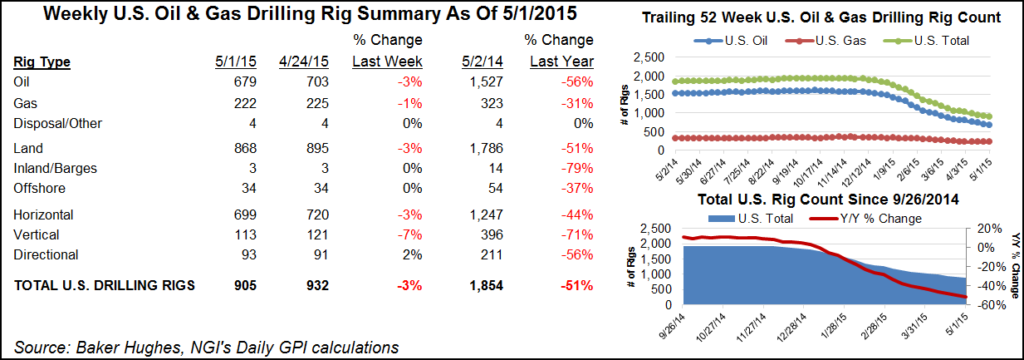U.S. Rig Count: It’s Been A Long Way Down
The average count of U.S. active drilling rigs in March was 478, down a whopping 632 units from the 1,110 rigs that were running in March 2015, according to Baker Hughes Inc. (BHI). And the count trekked lower still in the latest census, released on Friday.

For the week ending April 8, BHI said the number of U.S. land rigs running fell by six to 414. The offshore lost one unit for a net U.S. decline of seven rigs to 443 active (414 on land).
Eight U.S. oil-directed rigs left service while one gas-directed rig returned. The horizontal and vertical tribes each saw five of their kind leave, offset by the return of three directional units. Texas lost the most rigs, dropping seven units to end at 197 active. That’s down from 427 one year ago.
In Canada, three oil-directed rigs departed, joined by five natural gas rigs for a net decline of eight units to end at 41 active for the week. Alberta dropped four rigs; British Columbia, three, while Saskatchewan added one unit to end with a total of two active, and Newfoundland-Labrador offshore lost two units.
“We continue to see the North American rig count bottoming some time in 2Q and beginning to increase in 4Q16,” Cowen and Company analysts said in an April 5 note. “International and offshore will be slower to respond as activity has yet to adjust to sub-$60/bbl oil prices. We continue to expect a range-bound commodity environment with U.S. production responding to any strength in commodity prices. As a result, we see a choppy recovery…”
Indeed, U.S. producers have proven that they know how to produce, and then some. When rigs do get called back to the patch, they will likely be more prolific than ever if the trend holds true.
“…[N]early every major play saw some improvements in productivity in 2015 measured via initial production rates, but the rate of improvement varied drastically as some areas are quite mature in their development (Bakken and Eagle Ford),” BTU Analytics said in a recent note. “The Central Midland area in the Permian Basin has been a clear winner in growth in initial production rates, with 677 horizontal wells reporting an average initial production rate 27% higher than the 648 wells that were reported in 2014.”
Coming in second, BTU Analytics said, was the Powder River Basin, where results from Devon Energy Corp., EOG Resources Inc., Chesapeake Energy Corp., and Encana Corp. continue to improve.
© 2024 Natural Gas Intelligence. All rights reserved.
ISSN © 1532-1231 | ISSN © 2577-9877 |
